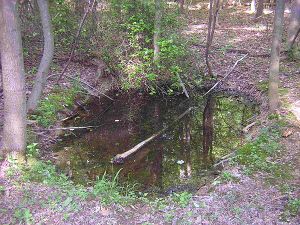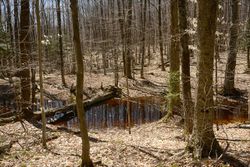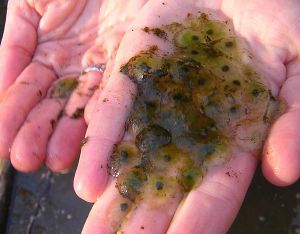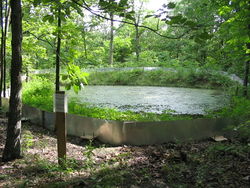Vernal Pools
Overview

Vernal pools are defined as isolated, seasonal wetlands that are characterized by being relatively small, shallow, and ephemeral. These features are filled in the spring by rain and snow melt, and they dry up near the end of summer when evaporation rates and temperatures are at their highest. They last the longest against evaporation when the depressions are lined with thick Clay, which slows the percolation rate of precipitation into the soil.[4] These pools form not only near other wetlands, but also in low lying areas with soil structures capable of holding water on top of the organic layer, or the Humus layer, of the Soil Horizons.
These seasonal wetland bodies are vital ecosystems for various Organisms including but not limited to amphibians, Insects, birds, and crustaceans. Vernal pools have been found on the tops of upland areas, woodlands, and urban areas. The key characteristic that contributes to the importance of these pools is that they are separated from other water bodies. When considering the characteristics of vernal pools, it is evident that vernal pools are unique and temporary wetland ecosystems. [13]
Formation
In order for vernal pools to form, many factors have to align. The Topography, water table (sometimes), soil history, and Soil processes all have to be just right before a vernal pool will take shape. Most vernal pools only occur in the Western Region and the Northeastern Region of the United States. They will form however in many parts of Canada, and many other Mediterranean or Subtropical regions on earth. [14]
The topography of a region is very important in an area that has vernal features. They're most typically found in flat lying areas with large depressions formed in the ground.
The type of rock in the area will also assist in the formation of vernal pools. If there is igneous rock or bedrock underneath the soil, the formation of vernal pools will be promoted greatly. Even if the rock is suspended on a hill or a mountain, it creates a situation where the infiltration of water into the soil is limited because the rock is essentially impermeable shortly under the ground. [14] If there is a hard clay based layer in the soil, that will also assist in keeping the water pooled on top.
Most believe that the water table in a region is the sole reason behind vernal pool formation, but this is not the case. Although the water table in an area can be extremely important in vernal pool formation. If the area has a higher water table, vernal pool formation will be promoted because water is more likely to pool up on the surface in the Spring months and create vernal pools; This is common in wetland areas and near stream beds. However, the water table does not have to be high in order for a vernal pool to form. Vernal pools can form due to the rock below and holding runoff in an area, creating a suspended water table or a lower infiltration rate in that area. [14]

The soil in an area is often the fundamental reason that vernal pools are able to form in an area. Mainly because of what geological feature existed there once before. Areas that promote vernal pool formation are areas effected by glacial action, floodplains, sag ponds, and even areas with human activity. Floodplains are common areas for vernal pools because when there is high water or even a flood, areas that have a water pocket will remain full of water for a short period of time. This is most common in the spring where there is high amounts of snow melt and rain, thus making vernal pools.
Areas that have been effected by glacial action are very susceptible to vernal pools because of the way that the glaciers leave the ground. Glaciers create many depressions, scrapes, scours, and erosion in areas where they travel or melt away. The Northeastern region of the United States is the way it is mostly because of the glacial sheet that last retreated. These features that are left behind form glaciers are able to fill with precipitation and become a vernal pool. A sag pond is created when there is an underlying rock that is weathered relatively easily. When the rock under the soil weathers, a depression will form in the soil above to fill the void of non-existent rock. This then creates an area for the water to pool, and to stay because of the rock below the soil.
Humans are also responsible for creating vernal pools because of their importance to the ecosystem. Vernal pools are becoming more and more rare due to human activity, so manmade vernal pools have been designed that allow and promote amphibians and insects to have a habitat once again. Also, many human activities like mining and ditch digging have a side effect that is perfect for vernal pools to form.
Ecological Importance
Vernal pools are the best habitat for many insects, amphibians, and plants; although their time frame before drying out may be short. The main advantage that vernal pools have over other bodies of water is that there's a lack of predatory aquatic species in the water. Additionally, many birds will use the vernal pool as a seasonal water source if it is large enough. Although much of the importance tied to vernal pools is due to the overwhelming amount of biodiversity interactions in the systems, including rare invertebrates, crustaceans, insects, and plant species.
Various plant communities also play an important role in the vernal pool's sub-ecosystem. In the spring-time, wildflowers often bloom in circles on the shoreline of each pool and by time summer ends they're replaced with dry, cracked soil. [12] Plant species that are found in vernal pools must be adapted to the high desiccation rate and stressful conditions that are present in the pools. These miniature wetlands thrive during and preceding the rainy season, with some staying dried up for up to 6 months. [8] Some rare (and endangered) plant species that thrive in vernal pools are, Shumards Oak, Raven's-foot sedge, squarrose sedge, and false hop sedge. [11]
Some rare animal species that depend on vernal pools are, Tiger Salamander, Fairy Shrimp, and specifically female bees of the genus Andrena. [6]

A wide array of fauna utilize vernal pools for their entire life, which can last up to decades in many cases. The hydrologic cycle of vernal pools is one of the key aspects that make animal life in the pools so specific. This includes the time of inundation, size, depth change, evapotranspiration, and Water Behavior in Soils. Factors like water temperature, Soil chemistry, surrounding habitats, and Biodiversity interactions are what allows the wetlands to return annually. Many species that are found in vernal pools live their first few stages in the pool and then leave, others will stay put after the water dries up. Amphibians like frogs and salamanders typically will only stay in the vernal pools until they dry up. Organisms like the fairy shrimp will stay during the entire period of the vernal pool. Fairy shrimp eggs can be laid as cysts for decades before they are exposed to a water source, which is typically a vernal pool. Fairy shrimp will live typically for only a few months after they hatch because of natural reasons, including desiccation. [11]
Declining Habitat
Unfortunately, vernal pools have been in a state of decline since industrialization has become more frequent. Some of the earliest restoration efforts were made in 1980 by the Nature Conservancy, whose members started to buy areas in California containing the pools in order to preserve them.[2] Conservation efforts are difficult because of the ephemeral characteristic of the wetlands and the lack of education surrounding them.
Directly correlated to the rule of humans on planet earth, vernal pools are in a serious decline. This is a great problem for many species that are entirely dependent on vernal pools for survival. Wetlands are some of the most valuable ecosystems because of their biodiversity and ecosystem services, vernal pools should not be excluded from this classification under wetlands. The biggest issue facing these sub ecosystems is development and destruction of forests, where most vernal pools can be located. Most real estate developers consider them to be obstacles in the development process; so regulation has been put into place in some areas that require fees to be paid in order to get a permit to build on these sites.[1] Vernal pools are abundant in forests in the Northeast and Western states, and when the forests are destroyed for human use, the vernal pools are ultimately succumbed as well. From 1800 to to 2018, forest coverage in Michigan alone has dropped from 89% to 45% and is continually approaching a lower percentage.[11]
Climate change has already shown affects on vernal pools in places like North Carolina[9], California[3] and others. With increasing temperatures and overall less precipitation, the pools will not get a chance to (i) properly form (ii) stay for over one season and (iii) support the soil Animals and microfauna that depend on these features for habitat.
Lack of Research
Vernal pools are not studied extensively, and as a result of this, humans are unintentionally destroying these important habitats. Research can help and may be the greatest proponent for these pools because they can prove their importance to the world. Researching every aspect of vernal pools is a necessity for their future conservation and restoration. Without the research, vernal pools will continue to face a serious decline, resulting in endangerment or extinction of fauna, plants, and natural services provided.

Restoration
Beyond the efforts of lawmakers charging fees for building, some restoration ecologists are designing faux pools to mitigate impacts of the disappearing, naturally occurring ones. There is an adaptive management approach that comes along with man-made vernal pools, as there is no way to assure working condition until they go through a subjective trial and error phase. These are considered as a last resort once the elimination of a natural pool is unavoidable.[5]
Documented projects and monitoring show that amphibian reproduction is severely inhibited and almost non-existent. The created wetlands tend to be more permanent than ephemeral, exposing larvae and breeders to more predators over time.[5] The improper hydrological regime in designed pools can be directly attributed to the failure of reproductive success with amphibians and other vernal pool breeders.[7]
References
1. Adams, Jill U. “Pooling Resources.” Science, vol. 350, no. 6256, 2 Oct. 2015, pp. 26–28., doi:10.1126/science.350.6256.26. [5]
2. Baskin, Yvonne. "California's ephemeral vernal pools may be a good model for speciation." BioScience, vol. 44, no. 6, 1994, p. 384+. Science In Context, http://link.galegroup.com.gate.lib.buffalo.edu/apps/doc/A15536169/SCIC?u=sunybuff_main&sid=SCIC&xid=203d3f61. [6]
3. Bauder, Ellen T. "Inundation effects on small-scale plant distributions in San Diego, California vernal pools." Aquatic Ecology 34.1 (2000): 43-61. [7]
4. Brown, Kathryn S. “Vanishing Pools Taking Species With Them.” Science, vol. 281, no. 5377, 1998, p. 626., doi:10.1126/science.281.5377.626a. [8]
5. Calhoun, A. J. K., et al. “Creating Successful Vernal Pools: A Literature Review and Advice for Practitioners.” Wetlands, vol. 34, no. 5, 17 July 2014, pp. 1027–1038., doi:10.1007/s13157-014-0556-8. [9]
6. “California Vernal Pools.” VernalPools.Org - Plants & Animals of Vernal Pools, [10]
7. Denton, Robert D., and Stephen C. Richter. “Amphibian Communities in Natural and Constructed Ridge Top Wetlands with Implications for Wetland Construction.” The Journal of Wildlife Management, vol. 77, no. 5, 2013, pp. 886–896., doi:10.1002/jwmg.543. [11]
8. Hocking, Daniel J. “Creating Vernal Pools.” Daniel J. Hocking, 22 July 2014, danieljhocking.wordpress.com/2014/07/22/creating-vernal-pools/. [12]
9. Montrone, Ashton, et al. “Climate Change Impacts on Vernal Pool Hydrology and Vegetation in Northern California.” Journal of Hydrology, 27 Apr. 2019, doi:10.1016/j.jhydrol.2019.04.076. [13]
10. Murtagh, Ed. “Vernal Pools.” Friends of Sligo Creek, Takoma Park Newsletter, Aug. 2004. [14]
11. Thomas, S.A., Y. Lee, M. A. Kost, & D. A. Albert. 2010. Abstract for vernal pool. Michigan Natural Features Inventory, Lansing, MI. 24 pp [15]
12. “Vernal Pools.” EPA, Environmental Protection Agency, 6 July 2018, accessed 4 May 2019. [16]
13. “Vernal Pools.” Vernal Pools Animals, www.naturalheritage.state.pa.us/VernalPool_Geology.aspx. [17]
14. “Vernal Pool EarthCache.” GC2G67F Diamond Head Crater (Earthcache) in Hawaii, United States Created by Martin 5. [18]